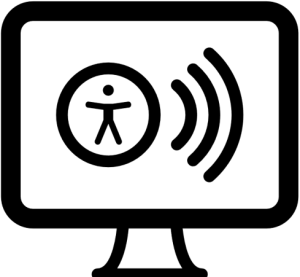 Educational digital accessibility is often viewed as a set of practices dedicated that assist disabled individuals with challenges to participate in online and blended courses. In fact, accessibility practices endeavor to more than eliminate barriers to education; they ensure that digital content is enhanced for everyone. Digital accessibility practices are something we all should practice because:
Educational digital accessibility is often viewed as a set of practices dedicated that assist disabled individuals with challenges to participate in online and blended courses. In fact, accessibility practices endeavor to more than eliminate barriers to education; they ensure that digital content is enhanced for everyone. Digital accessibility practices are something we all should practice because:
- they remove barriers to education and training
- legislation requires accessibility across Canada
- many Canadians live with at least 1 disability
- they improve all digital resources for all users
- it is the right thing to do
I will be facilitating two webinars in March that will introduce accessibility practices for language teachers and demonstrate practical applications in the avenue.ca LMS.
Webinar: Digital Accessibility for Language Instructors
- Monday, March 21st 7PM ET – Achēv’s Language Curriculum Training Services (LCTS) – Ontario
- Monday, March 28th 7PM ET – Tutela Membership
In April I will facilitate a hands-on webinar that will allow participants to practice accessibility and practical applications in using Microsoft Word LMS.
Webinar: Digital Accessibility Hands-on Workshop for Language Instructors
- Monday, April 11th 7PM ET – Tutela Membership
Supporting Digital Accessibility
Each of us can contribute to the advancement of digital accessibility in our institutions and our professional learning networks (PLN) and move the needle to make learning materials more accessible for everyone. Ways to contribute include learning more about digital accessibility, practicing digital accessibility with your teaching and development, advocating for more digital accessibility, and experiencing and empathizing with the real experience of challenged users.
Learn
At this point, most understand the concept of accessibility and are acquainted with digital accessibility through our mobile devices and prominent resources such as Microsoft Word, browsers or Zoom. When using these tools, we are the benefactors of the coordinated efforts of accreditors and software designers. As educators we are challenged to learn more accessibility features and practices that will benefit learners. Accessibility is an extensive field and learning about it includes:
- learning general accessibility principles (e.g., WCAG Guidelines)
- learning resource specific features (e.g., Microsoft Office accessibility options)
- learning operating system features, (e.g., IOS Accessibility settings)
- asking learners to articulate their access issues
To meet this challenge there are webinars, videos, courses, certifications, online groups, and government resources available for your consideration. Having taken six accessibility courses, I know that I still have a long way to go to become an expert. However, I am applying my knowledge toward my instruction, peer support, learning materials development and advocacy to improve my practice.
Practice
After reading, viewing, or taking part in accessibility professional development, lessons learned should be applied to your practice. Instructors in our field should:
- use accessibility practices when creating or modifying learning materials (e.g., image ALT tags)
- use accessibility practices when teaching (e.g., Zoom automatic live captioning)
- document lessons learned for future purposes
Incorporating accessibility features into course materials takes time and effort. The more that it becomes a habit, the less energy it will take, especially if teachers learn how to repurpose learning materials.
Advocate
In your organization or in cooperation with your PLN, start promoting digital accessibility. It is not easy being a change agent; however, these changes have been moving forward for more than a decade already and you can add to this momentum.
A few ideas are:
- Research your organization’s resources dedicated to web accessibility.
- Locate your organization’s accessibility objectives, create personal objectives that align with your accessibility goals. Request the necessary resources to meet them. Share your experience with others within the organization.
- Join or create an accessibility team /committee.
- Request relevant and practical accessibility professional development.
- Demand that all purchased educational resources are WCAG 2.1 compliant.
- Facilitate practical accessibility professional development sessions in your organization.
- Demand that all future purchases of authoring tools are accessibility compliant.
Empathize
In order to truly practice web accessibility as an educator and an educational developer, experience using digital tools on relevant materials. This would include locating and using a screen reader. This means a real screen reader, not just the attachments on Microsoft Office or browsers. For example, the NVDA app reveals how difficult web content is to navigate. Another means of empathizing with accessibility issues is to invite people with disabilities to share their lived experience of disabilities with you and your peers.
Final thoughts
Most language educators are embarking on the process of integrating good accessibility practices. It takes time and effort to integrate accessibility into your courses and instruction; however, the rewards include improving end user experience, increasing potential users and learning material consistency. If you have any comments about enhancing educational web accessibility, please add them below.
Resources
Colour contrast WebAIM Web Accessibility Evaluation Tool
H5P Accessibility Content Type Tracker, https://documentation.h5p.com/content/1290410474004879128
Improve Communication with Plain Language, https://www.elearningworld.org/improve-communication-with-plain-language
Moodle WCAG 2.1 Level AA accreditation, https://moodle.com/news/moodle-wcag-2-1-aa-accessibility-compliance
Moodle Accessibility Block Plug in, https://docs.moodle.org/311/en/Accessibility_Block
Moodle Accessible Course Design for Teachers, https://docs.moodle.org/310/en/Accessible_course_design
Meeting WCAG 2 (Quick reference), https://www.w3.org/WAI/WCAG21/quickref
NVDA, Screenreader, https://www.nvaccess.org
Teachers, repurpose with purpose, https://www.elearningworld.org/teachers-repurpose-with-purpose
WCAG 2 Guidelines, https://www.w3.org/WAI/standards-guidelines/#wcag2

There is so much to impact here but accessibility policies are really a way of improving access and equity for learners. Looking forward to your webinars Mr. Allan.